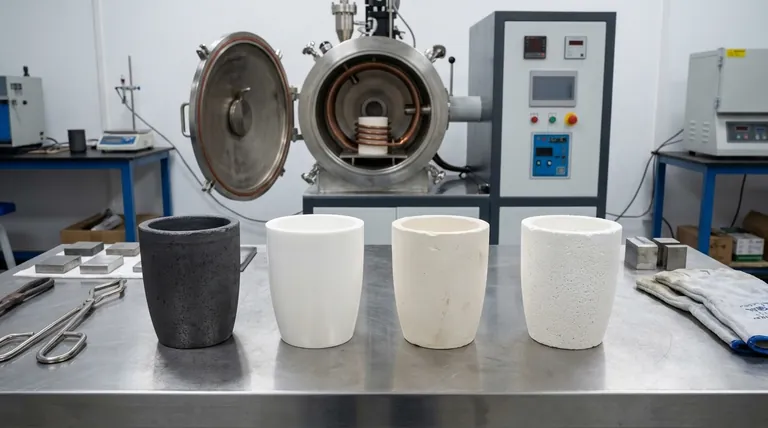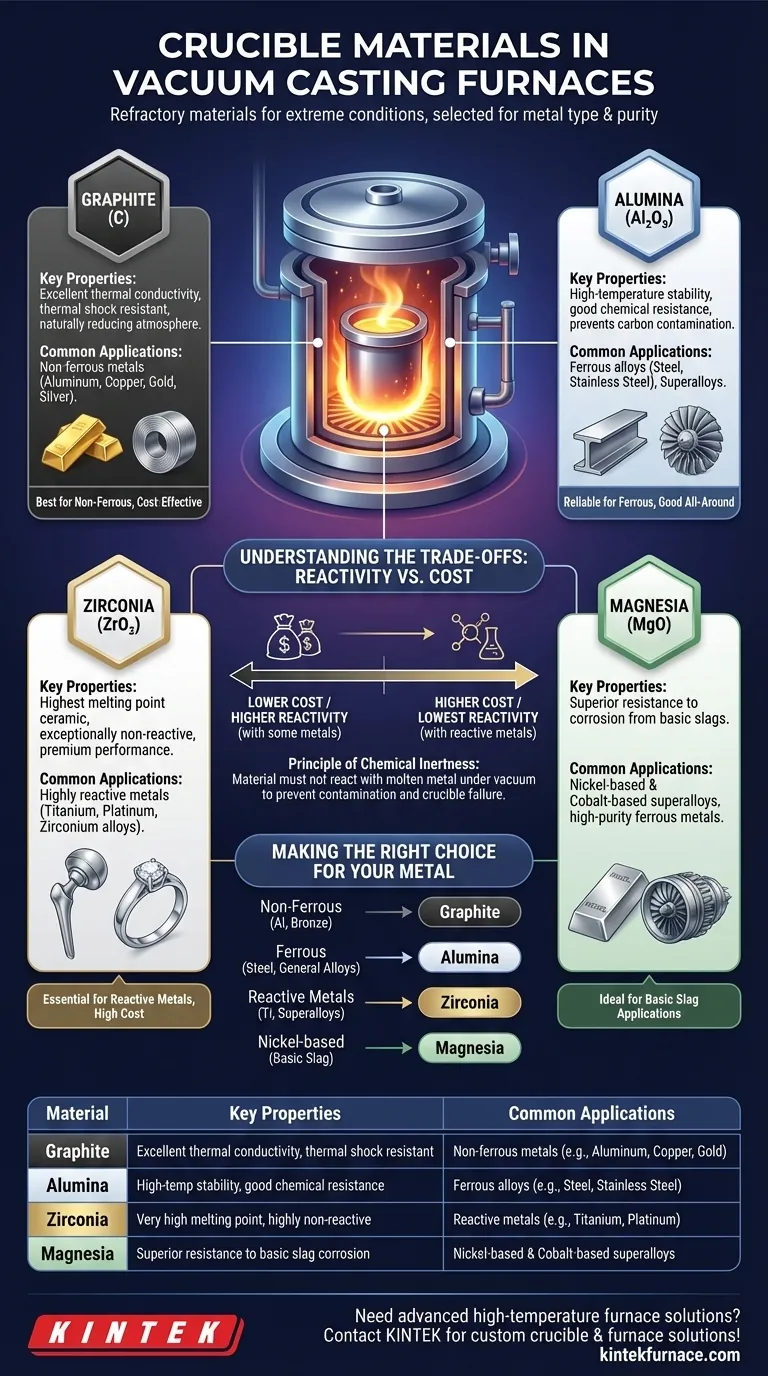In vacuum casting furnaces, crucibles are made from a specific class of refractory materials designed to withstand extreme conditions. The most common materials are graphite, alumina (Al₂O₃), zirconia (ZrO₂), and magnesia (MgO), with the final selection depending entirely on the metal being melted and the required purity of the final cast.
The selection of a crucible material is not a simple preference; it is a critical engineering decision. The right material must remain chemically inert with the molten metal at extreme temperatures and under vacuum to prevent contamination and ensure the integrity of both the cast part and the crucible.

The Purpose of a Specialized Crucible
In any casting process, the crucible's basic job is to contain molten metal. In a vacuum furnace, this role is far more demanding.
The material must not only have an extremely high melting point but must also remain stable under vacuum, resist intense thermal shock, and, most importantly, avoid reacting chemically with the highly-energized molten metal it holds.
A Breakdown of Common Crucible Materials
Each material offers a unique profile of thermal resistance, chemical inertness, and cost. Understanding these profiles is key to selecting the correct crucible for your application.
Graphite (C)
Graphite is a workhorse material valued for its excellent thermal conductivity, which allows for rapid and uniform heating of the metal charge. It is also highly resistant to thermal shock.
It is the preferred choice for melting most non-ferrous metals like aluminum, copper, and precious metals like gold and silver. Its naturally reducing atmosphere helps prevent oxidation of the melt.
Alumina (Aluminum Oxide, Al₂O₃)
High-purity alumina is an excellent all-around material known for its high-temperature stability and good chemical resistance against a wide variety of metals.
It is often used for melting ferrous alloys like steel and stainless steel, as well as various superalloys, where the carbon from a graphite crucible would be an unacceptable contaminant.
Zirconia (Zirconium Dioxide, ZrO₂)
Zirconia sits at the peak of performance and cost. It has one of the highest melting points of any ceramic and is exceptionally non-reactive.
This makes it the essential choice for melting highly reactive metals such as titanium, platinum, and zirconium alloys. Using any other material would result in severe contamination of the melt and likely destroy the crucible.
Magnesia (Magnesium Oxide, MgO)
Magnesia crucibles are known for their superior resistance to corrosion from basic slags, which are often produced when melting certain alloys.
They are primarily used for melting nickel-based and cobalt-based superalloys, as well as some high-purity ferrous metals, where its specific chemical inertness offers an advantage over alumina.
Understanding the Trade-offs: Reactivity vs. Cost
Choosing a crucible involves balancing the risk of chemical reaction against the operational cost. Using the wrong material is a guarantee of process failure.
The Principle of Chemical Inertness
The primary goal is to find a material that the molten metal cannot dissolve or react with. A molten metal is chemically aggressive and will readily form new compounds (like carbides from graphite or oxides from a ceramic) if the crucible material is not stable in its presence.
This reaction contaminates the final cast part, altering its mechanical properties, and simultaneously degrades the crucible, leading to premature failure.
The Cost vs. Performance Spectrum
There is a direct correlation between a crucible's performance with reactive metals and its cost.
Graphite is often the most cost-effective option, but its use is limited to less reactive metals. Alumina represents a significant step up in capability and cost. Zirconia is a premium, specialized material, costing many times more than alumina but being the only option for the most demanding applications.
Making the Right Choice for Your Metal
Your decision should be dictated by the specific alloy you are casting.
- If your primary focus is casting non-ferrous alloys like aluminum or bronze: Graphite often provides the best balance of performance and cost-effectiveness.
- If your primary focus is casting most steels or general-purpose alloys: High-purity Alumina is a robust and reliable choice that prevents carbon contamination.
- If your primary focus is casting reactive metals like titanium or superalloys: Zirconia is the necessary choice, despite its higher cost, to ensure melt purity.
- If your primary focus is casting nickel-based alloys that produce basic slag: Magnesia offers superior chemical resistance for these specific applications.
Matching the crucible material to your specific metal and process is the foundational step toward achieving a successful, high-purity cast.
Summary Table:
| Material | Key Properties | Common Applications |
|---|---|---|
| Graphite | Excellent thermal conductivity, resistant to thermal shock | Non-ferrous metals (e.g., aluminum, copper, gold) |
| Alumina | High-temperature stability, good chemical resistance | Ferrous alloys (e.g., steel, stainless steel) |
| Zirconia | Very high melting point, highly non-reactive | Reactive metals (e.g., titanium, platinum) |
| Magnesia | Superior resistance to basic slag corrosion | Nickel-based and cobalt-based superalloys |
Struggling to select the right crucible material for your vacuum casting process? KINTEK leverages exceptional R&D and in-house manufacturing to provide advanced high-temperature furnace solutions, including Muffle, Tube, Rotary Furnaces, Vacuum & Atmosphere Furnaces, and CVD/PECVD Systems. Our strong deep customization capability ensures we can precisely meet your unique experimental requirements, helping you achieve high-purity casts with the perfect crucible material. Contact us today to discuss your needs and enhance your lab's efficiency!
Visual Guide

Related Products
- Vacuum Induction Melting Furnace and Arc Melting Furnace
- 600T Vacuum Induction Hot Press Vacuum Heat Treat and Sintering Furnace
- High Pressure Laboratory Vacuum Tube Furnace Quartz Tubular Furnace
- Vacuum Sealed Continuous Working Rotary Tube Furnace Rotating Tube Furnace
- Vacuum Hot Press Furnace Machine Heated Vacuum Press Tube Furnace
People Also Ask
- What are the key benefits of using vacuum melting furnaces? Achieve Superior Purity and Control for High-Performance Alloys
- What are the advantages of vacuum induction melting? Achieve Superior Purity for High-Performance Alloys
- What components make up a Vacuum Induction Melting Furnace? Discover the Key Systems for Pure Metal Melting
- What are the key features and benefits of a Vacuum Induction Melting Furnace? Achieve High-Purity Metal Production
- What industries benefit from Vacuum Induction Melting Furnaces? Unlock High-Purity Metals for Aerospace, Medical, and More



















